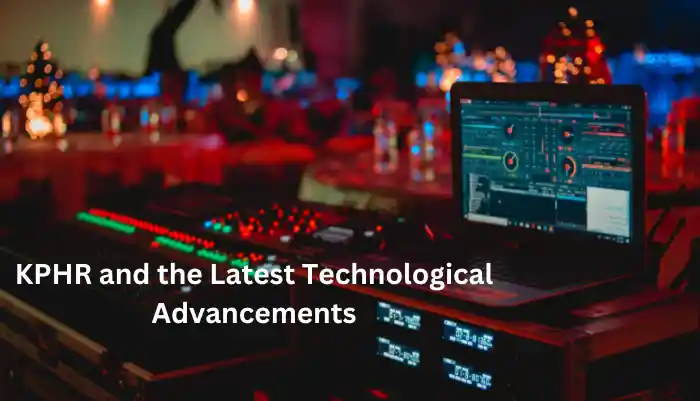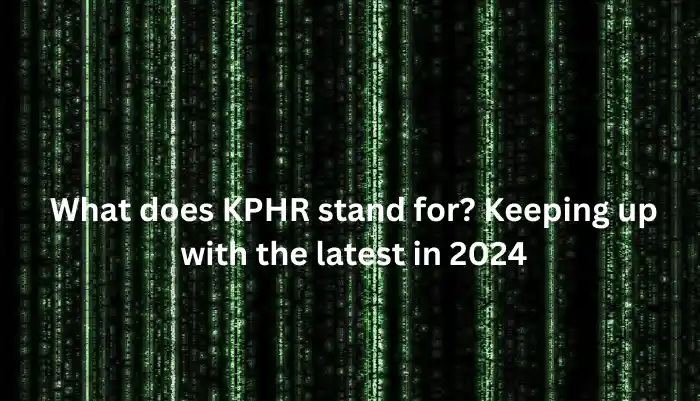What does KPHR stand for? Keeping up with the latest in 2024
In 2024, everyone’s talking about KPHR. There’s a strange term making waves in IT, headlines, and social media. But fear not—you are in safe hands with us! Come along as we examine what KPHR means, how it works in real life, and why it’s revolutionary. Prepare to look through the commotion and witness how this term influences things in 2024.
Decoding KPHR and its Significance
In the ever-changing world of HR, KPHR isn’t just another trendy term; it’s a potential game-changer. Whether it means focusing on Knowledge, Performance, Happiness, and Recognition or aligning with Key Performance-driven Human Resources, one thing is clear – KPHR signals a shift to a more strategic and people-focused approach.
It’s about valuing continuous employee growth, providing ongoing feedback, caring about employee happiness, and recognizing contributions meaningfully. Why does it matter? KPHR transforms workplaces, attracting top talent, boosting engagement, and creating a positive work culture. Embracing KPHR principles means navigating a more enjoyable and productive work experience for everyone involved.
Origin and History of KPHR
KPHR first appeared in October 2023 on tech forums and social media, where discussions about future HR trends were happening. By November, it started getting noticed by HR publications, leading to speculation about its meaning. In December, it became more prominent on major social platforms like Twitter and LinkedIn, and by January 2024, news outlets were talking about its potential impact on HR practices.
Some common interpretations include seeing it as Knowledge, Performance, Happiness, and Recognition, focusing on overall well-being, or as Key Performance-driven Human Resource, emphasizing strategic alignment. Another simpler view suggests Keep People Happy & Rewarded, emphasizing employee satisfaction and motivation. This journey from tech discussions to widespread speculation highlights how quickly KPHR gained attention in just a few months.
Read More: https://asseturi.com/the-secret-logic-myhrkp-for-boosting-employee-morale-in-2024/
KPHR and the Latest Technological Advancements

In the ongoing exploration of KPHR, its meaning is still up for interpretation, presenting an intriguing connection to the latest tech trends. Imagine KPHR standing for Knowledge, Performance, Happiness, and Recognition—it fits well with the push for tech that prioritizes people. This could mean AI-driven learning, real-time performance feedback, tech-enhanced wellness programs, and recognition tools fostering a positive work culture.
Alternatively, KPHR might represent specific tech trends like wearable interfaces, AI-powered talent analytics, or holistic well-being platforms. While KPHR’s future is uncertain, its rise signifies a call for tech that empowers individuals, marking a significant shift towards human-centric technology in our ever-changing digital landscape.
KPHR in Action: Exploring its Applications and Implications
The term KPHR has piqued curiosity and generated many theories, but let’s transition from speculation to practical exploration. What could KPHR mean in action?
Enhancing Employee Well-being:
To boost employee satisfaction, KPHR stands for Knowledge, Performance, Happiness, and Recognition.
– AI-driven learning platforms could suggest personalized training for continuous skill development.
– Real-time performance feedback systems could replace the traditional annual reviews.
– Wearables and stress-tracking apps integrated into HR platforms could provide personalized mental health support.
– Social recognition systems might foster a culture of appreciation and motivation.
Transforming Talent Management:
If KPHR stands for Key Performance-driven Human Resource, it could reshape talent management strategies.
– AI-powered talent analytics might match individuals with roles that optimize their performance.
– Robotic Process Automation (RPA) could handle repetitive HR tasks, freeing time for strategic initiatives.
– Predictive models could map out dynamic career paths, encouraging employee growth and retention.
– Data-driven talent acquisition platforms might identify the best candidates for organizational fit.
Adapting to the Future of Work:
KPHR also signals broader shifts in how we work.
– Wearable technology and haptic feedback systems could revolutionize employee training.
– Augmented reality (AR) could enhance onboarding by overlaying instructions onto real-world environments.
– Collaboration tools and virtual reality spaces might optimize remote work experiences.
– Focusing on mental health could inspire initiatives balancing well-being with performance considerations.
Considerations for Implementation:
While the potential of KPHR is exciting, it comes with challenges:
– Safeguarding data privacy requires ethical considerations and robust protection measures.
– Mitigating bias in AI-powered platforms is essential for fairness and equal opportunities.
– As the role of HR professionals evolves, continuous learning is crucial for navigating new technologies and data-driven approaches.
Challenges and Opportunities in KPHR
The mysterious KPHR acronym has intrigued many, and the potential to reshape talent management and work dynamics lies beneath the speculation. However, this journey isn’t without obstacles—privacy concerns, algorithm biases, the need for ongoing learning, and ethical considerations. Conversely, KPHR brings promising opportunities—empowering employees, transforming talent management, fostering collaboration, and emphasizing well-being. This journey calls for a shift toward a people-centric approach to work, using technology as a tool for progress. Prioritizing ethics, investing in skills, and focusing on well-being can make KPHR a positive force, shaping a future where work is thriving.
Conclusion
Not just a trend, KPHR is an unsolved acronym in HR that may hold the key to connecting tech transformation with human-centered work. While the term is unclear, KPHR promotes a change to an employee experience that is more data-driven, well-being-focused, and human-centric.
Implementing KPHR faces challenges like data privacy and algorithmic bias but offers vast rewards. Envision a future with personalized learning, data-optimized talent management, and well-being woven into work—a thriving workplace where technology enhances human potential.
FAQs
- What does KPHR mean in HR, and why is it getting attention?
KPHR is a code term indicating Awareness, Efficiency, Joy, and Acknowledgment. It’s becoming increasingly popular in HR since it can revolutionize employee experience management by merging technology with an approach that prioritizes people.
- How can companies adopt KPHR principles in their HR practices?
Companies can start by fostering continuous learning, providing real-time performance feedback, and cultivating a positive workplace culture. Recognizing and appreciating employee contributions align with the core values of KPHR.
- Is KPHR more relevant to specific industries?
While adaptable, KPHR finds resonance in industries emphasizing employee well-being, such as technology, healthcare, and innovative sectors.
- What challenges might arise when implementing KPHR, and how can they be addressed?
Issues with data protection, possible prejudices, and the requirement for HR experts to upgrade their skills are among the difficulties. Commitment to frequent staff training, robust privacy laws, and constant bias analysis is essential to overcome such challenges.
- Is KPHR a one-size-fits-all solution, or can it be tailored to individual organizations?
KPHR is flexible, offering guiding principles that organizations can customize to align with their unique values. This ensures resonance with employees and overall performance optimization based on specific organizational needs.
Click Here to read more about Asseturi.














Post Comment